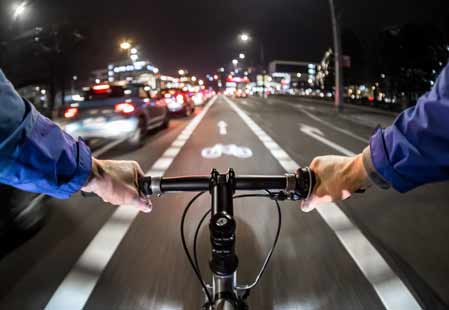Pedestrian deaths in the U.S. have increased by 46% over the last decade. Meanwhile, U.S. cycling deaths have increased by 44% over the same period, with experts blaming road designs that are prioritized entirely towards cars and don’t take into consider pedestrian and cyclist usage.
Pedestrians and cyclists have just as much right to the road as drivers and deserve to be and feel safe. The alarming truth is that pedestrians and cyclists are far more vulnerable to injury in collisions, and just about everyone who frequently walks or bikes has at least one story of a close call, if they haven’t already been struck by a car.
The most common excuse we hear from drivers who have injured our clients is “I didn’t see them!” Unfortunately, when the sun goes down early in the fall and winter months, the risk of collisions goes way up for pedestrians and cyclists.
While we do everything we can to fight for the rights of people injured by reckless, drunk, drowsy, and distracted drivers, it’s more important for us to make sure fewer people are injured in the first place.
Watch: Gary Bruce discusses drowsy driving.
For that reason, we urge pedestrians and cyclists to follow these tips anytime they go out after dark.
Tips for Pedestrians
- Whenever possible, walk only on sidewalks. If no sidewalks are available, walk on the side of the road facing oncoming traffic. This prevents cars coming up behind you unseen, allows drivers to see you more easily, and gives you more time to react if a car looks like it’s going to veer out of its lane.
- Whenever possible, walk in well-lit areas and avoiding taking shortcuts through dark side streets.
- Cross only at crosswalks and avoiding stepping out into the street from between parked cars where you may not be easily visible to oncoming drivers.
- Wear white or bright colors which are more easily visible in the dark, while avoiding black and other dark colors.
- Don’t look at your phone while walking. Not only will the screen’s brightness impair your night vision, it is also distracting. Studies show people texting while walking are less likely to look before crossing the street, and take longer to cross, putting them at higher risk of a collision.
- Always assume the driver of an approaching vehicle can’t see you. Wait for them to come to a complete stop at the traffic signal and try to make eye contact with them before crossing.
- Walk with a buddy. Larger groups are not only more visible to drivers, they offer more security from other threats.
Related Reading: Why Children are More Likely to be Injured in Pedestrian Accidents
Tips for Cyclists
- Plan your route ahead of time. Whenever possible, stick to well-lit and familiar roads with designated bike lanes. Avoid roads with high traffic.
- Make sure your bike has the appropriate lights installed.
- In Alabama, all bikes ridden on public roads are required to have a white light on the front that is visible from at least 500 feet away, and a red reflector on the rear that can be visible in headlights up to 600 feet away.
- In Georgia, all bikes ridden on public roads are required to have a white light on the front that is visible from at least 300 feet away, and a red reflector on the rear that can be visible in headlights up to 300 feet away.
- Add extra lights. When riding at night, the more lights you have, the better. While taillights are not legally required on a bike, it is a good idea to add one. It is important to note that any added taillight must legally be red. Blinking taillights are a particularly good choice because they are more likely to attract drivers’ attention.
- Add extra reflectors. Your bike should be visible from all angles. If not already equipped, add reflectors to the pedals, the wheel rims, and along the sides of the bike.
- Wear reflective clothing, such as a reflective vest or jacket, when cycling. You can also add reflective tape to your clothing and gear, such as the back of your shoulders, shoes, around your knees and ankles, and on your bicycle helmet.
- Bike with a friend. Drivers are more likely to spot two or more cyclists than one bike rider alone.
Hit by a Car While Walking or Cycling? Get Gary Bruce.
People in vehicles always have a greater responsibility to not injure other road users. People driving vehicles should be especially careful in school zones or where children might be walking, riding, or playing.
If you or someone you love was hit by a car when walking or riding after dark because that driver was speeding, distracted, or simply failed to look, they can and should be held liable for the harm they caused you.
Contact our firm today to discuss your claim.
